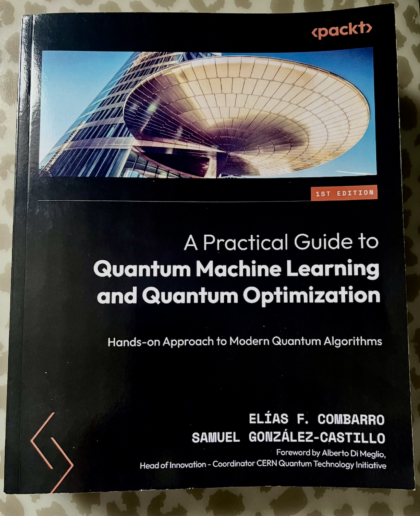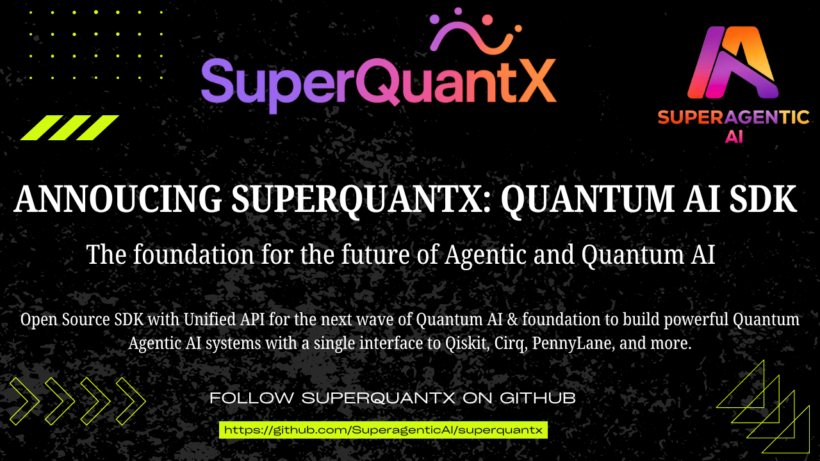Today is a landmark day for Superagentic AI. We are thrilled to introduce SuperQuantX, our open source SDK created to unify the fragmented world of Quantum AI development. The timing could not be more perfect. With the Quantum World Congress taking place next week from September 16 to 18 and the recent Quantum Agent research paper sparking fresh debate, we are stepping into the spotlight with a launch that could not be more timely. To make it even more exciting, SuperQuantX will also debut on Product Hunt, bringing this vision directly to the global developer and research community.
SuperQuantX provides a seamless way for researchers and developers to build quantum enhanced agentic systems using one unified interface. SuperQuantX is built for experimentation and for rigorous research work. It brings AI and quantum computing together in a way that lets you focus on ideas instead of integration effort. This project is the result of research at Superagentic AI and is intended to be a foundation for quantum enhanced agentic research. SuperQuantX aims to make it simple to write code once and run it on any supported quantum backend without rewriting your logic.
Background
Our journey into Quantum Machine Learning began with a book “Practical guide to quantum machine learning and quantum optimization“. The subject was fascinating but the tooling was fragmented. Each framework exposed its own API and its own conventions. oOften found spending more time wrestling with tool differences than testing research hypotheses. That experience motivated to build a unified platform where code stays constant and the backend can change.

The current quantum ecosystem offers many strengths but also forces researchers to juggle multiple SDKs and vendor specific quirks. That slows research and complicates collaboration. SuperQuantX removes that barrier by providing a single API for multiple frameworks, enabling reproducibility, faster validation, and greater creative focus on algorithmic progress rather than on integration details.
SuperQuantX provides one consistent API that connects to a wide set of quantum frameworks such as PennyLane, Qiskit, Cirq, Amazon Braket, TKET, and D Wave Ocean. With that single interface you can run the same research code across different backends while keeping experiments reproducible and portable. This reduces friction and accelerates iteration for teams and for individual researchers.
Features
- Unified API spanning PennyLane, Qiskit, Cirq, Amazon Braket, TKET, and D Wave Ocean.
- Seamless backend switching without changing research logic
- Tools tailored for agentic AI research and autonomous quantum driven systems
- Pre built quantum machine learning and optimization algorithms including QSVM Quantum Neural Network VQE and QAOA
- Circuit visualization and result analysis tools
- Cloud integration with managed simulators and hardware providers
- Comprehensive documentation and developer examples for fast onboarding
At Superagentic AI we believe that future intelligence will be both quantum enhanced and agentic. Our vision with SuperQuantX is to create a unified foundation for that future. We want to accelerate discovery, enable reproducible research, and make it straightforward to build autonomous quantum enhanced agents using a cohesive platform.
How It Works
SuperQuantX acts as a bridge between research code and vendor specific frameworks. You write circuits or agent logic using a consistent API. When you switch a backend the library handles the backend specifics such as transpilation scheduling differentiable programming integration or annealing configuration. This keeps your research code stable while letting you validate experiments across multiple providers.
Examples
Here is an example that creates quantum entanglement with minimal code.
import superquantx as sqx
backend = sqx.get_backend('simulator')
circuit = backend.create_circuit(2)
circuit.h(0) # Superposition
circuit.cx(0, 1) # Entanglement
circuit.measure_all()
result = backend.run(circuit, shots=1000)
print(result) # Expected: state counts close to balanced values
You can switch the backend easily to PennyLane, Qiskit, or Cirq by altering one parameter. That same example works across multiple frameworks without touching its logic
Advanced examples include constructing a Quantum SVM:
from sklearn.datasets import make_classification X, y = make_classification(n_samples=100) qsvm = sqx.QuantumSVM(backend='simulator', feature_map='ZFeatureMap') qsvm.fit(X_train, y_train) accuracy = qsvm.score(X_test, y_test)
And experimenting with hybrid algorithms such as VQE or Quantum Neural Networks:
vqe = sqx.VQE(backend='simulator', hamiltonian=H) ground_energy = vqe.find_ground_state() qnn = sqx.QuantumNeuralNetwork(n_qubits=4, n_layers=2)
Quick Video Demo
Quantum Not Here, But You can’t Ignore
Large scale quantum hardware is not widely available yet. That fact makes foundation building critical today. The research we do now will shape future breakthroughs. Fragmentation slows progress. SuperQuantX removes that barrier and enables researchers to validate across platforms collaborate across ecosystems and iterate faster on quantum enhanced methods.
Conclusion
SuperQuantX is the platform for exploring quantum machine learning. It transforms fragmentation into clarity and gives researchers a pragmatic and future ready foundation for quantum agentic research. This is the start of a longer journey and we are inviting the community to build with us.
SuperQuantX Useful Links
Homepage: Superagentic AI
GutHub : SuperagenticAI/superquantx
Docs: SuperQuantX Documentation
Product Hunt: SuperQuantX
Your feedback and contributions will be essential to making this ecosystem thrive. Try SuperQuantX to get you Quantum AI Journey started.

